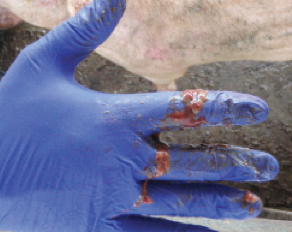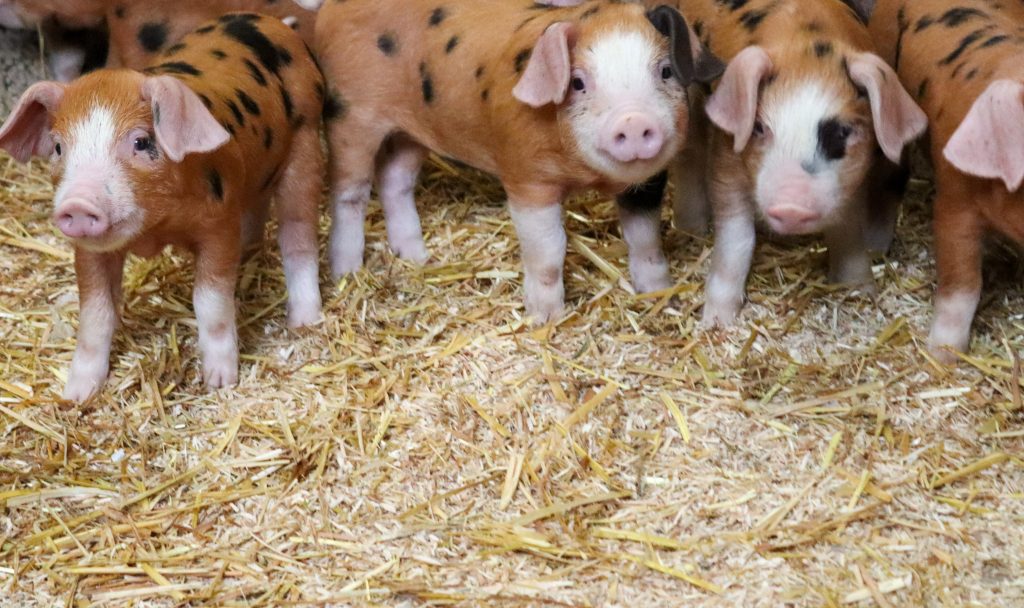
Swine Dysentery, Brachyspira hyodysenteria, a widespread and well-recognised disease among pigs globally, poses a significant threat across various pig keeping operations. It is present in the UK and it is wise that pig keepers are aware of diseases in and around your area/county.
Please ensure you are signed up to AHDB Disease Charter (using the same log in details when signing in for the eaml2). Being aware helps you to be prepared. As it could affect the movement of your pigs.
Clinical Symptoms
Swine dysentery has distinct clinical signs in affected pigs, such as a dull and depressed demeanour, displaying a lack of appetite.
Dehydration is a common consequence of the disease, the faeces may range from soft to almost watery consistency, containing blood, mucous, and, in severe cases there will be necrotic gut lining.
The course of the disease usually spans over several days. Initially, pigs may exhibit high temperatures, reaching up to 41°C (106°F). Mortality can occur early on or later in the disease course, often as a result of dehydration or salt poisoning. It is essential to closely monitor pigs showing these clinical symptoms and promptly seek veterinary attention to manage and treat the disease effectively.
Swine dysentery is primarily spread through infected pigs and their faeces. Anything contaminated with dung, such as vehicles, boots, and equipment, can serve as potential carriers and easily transmit the infection between farms. Vigilant biosecurity measures are crucial in preventing the disease’s spread and protecting pig populations from the risk of infection. Being mindful of where you are moving pigs from and too and being aware of the regional/county infection.
Pigs that survive swine dysentery infection often require treatment, leading to extended time to reach slaughter weight. This compromises the farm’s overall productivity and competitiveness, posing significant challenges for pig producers.
The disease poses a particularly severe threat to farms involved in breeding pigs. If breeding pigs become infected, it can devastate both their international and UK trade, significantly impacting the farm’s economic viability.
An infected pig farm not only endangers other local farms but also poses a risk to farms in other regions. The disease can spread through contaminated vehicles or pig movements, leading to potential outbreaks in previously unaffected areas.
Moreover, the limited range of available treatments for swine dysentery is facing increasing resistance from the disease. In some cases, the swine dysentery organism has become resistant to all available treatments, leaving depopulation as the only viable method to control the disease’s spread and prevent further outbreaks.
The seriousness of swine dysentery demands constant vigilance and the implementation of strict biosecurity measures to safeguard pig populations and the pig farming industry as a whole. Early detection, proper management, and collaboration among pig producers are essential in tackling this challenging and potentially devastating disease.
Prevention
Make use of AHDB free services for safer biosecurity measures and sign up to the Significant Diseases Charter. An important application which shares information quickly in the event of an outbreak.
It is worth noting that abattoirs pose a significant risk for cross-contamination of vehicles. Therefore, effective cleaning and disinfection protocols can successfully prevent such contamination.
If you suspect swine dysentery in your pigs, it is crucial to take immediate action:
- Observe for Diarrhoea and Wasting: Pay close attention to any pigs showing signs of unexplained diarrhoea and wasting. In particular, if the diarrhoea contains blood or mucus, this could be an indication of swine dysentery.
- Contact Your Veterinarian: As soon as you notice these symptoms, contact your veterinarian immediately for advice and assistance. They will provide guidance on the next steps and help confirm the diagnosis.
- Seek Diagnosis: Diagnosis of swine dysentery is achieved by submitting faeces or pig samples for testing. Your veterinarian will conduct appropriate tests to identify the presence of the disease.
- Implement Control Measures: If swine dysentery is confirmed, prompt diagnosis is essential for implementing suitable control measures. These measures are critical in limiting the spread of the infection to other pigs and farms.
By taking swift action and involving your veterinarian at the first sign of suspicion, you can effectively manage and control swine dysentery, minimising its impact on your herd and preventing the disease from spreading to other pig populations.
The Oxford Sandy and Black Pig Group is UK’s only pig breed that is a registered charity in England & Wales (1190463) and Scotland (SCO52662) We are creating a better future for our breed, the bloodlines and its breeding potential together with our Independent Pork Producers, Breeders and Keepers. Please click the donate button so we may continue to look after our breed and our supporters.
Follow us on Facebook and see how we support, help and inspire individuals about our rare breed
